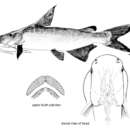Morphology
provided by Fishbase
Dorsal spines (total): 1; Dorsal soft rays (total): 7; Analspines: 0; Analsoft rays: 23 - 26
Trophic Strategy
provided by Fishbase
Occurs in turbid channels of main rivers and also in swampy lagoons and backwaters. Feeds almost exclusively on Macrobrachium and Caridina prawns.
- Recorder
- Drina Sta. Iglesia
Biology
provided by Fishbase
Occurs in turbid channels of main rivers and also in swampy lagoons and backwaters (Ref. 2847). Also found in river deltas and mangrove areas (Ref. 38478). Feeds almost exclusively on Macrobrachium and Caridina prawns (Ref. 2847).
Comprehensive Description
provided by Smithsonian Contributions to Zoology
Cochlefelis danielsi (Regan, 1908)
USNM 217086, Fly 75–17, 1: 405 mm.
USNM 217087, Fly 75–20, 4: 316–450 mm.
USNM 217088, Fly 75–25, 1: 318 mm.
Cochlefelis danielsi occurs sympatrically with C. spatula in large rivers in the Middle Fly but was not seen in the Upper Fly during the 1975 survey. It feeds almost exclusively on prawns; four individuals were examined that had ingested Macrobrachium of carapace lengths over 70 mm. Eyes lateral and relatively large. Gape extremely large; snout broadly rounded, projecting but very slightly beyond tooth band of upper jaw. Barbels without membranous inner margin. Total number of gill rakers on first gill arch 21–23. Pectoral fin usually with 10 branched rays. Anal pterygiophores 25. Adipose fin relatively small and caudal peduncle much shorter than in C. spatula. Large specimens with 50–51 free vertebral centra.
- bibliographic citation
- Roberts, Tyson R. 1978. "An ichthyological survey of the Fly River in Papua New Guinea with descriptions of new species." Smithsonian Contributions to Zoology. 1-72. https://doi.org/10.5479/si.00810282.281
Daniel's catfish: Brief Summary
provided by wikipedia EN
The Daniel's catfish (Cochlefelis danielsi) is a species of catfish in the family Ariidae. It was described by Charles Tate Regan in 1908, originally under the genus Arius. It is found in brackish and freshwaters including rivers, lagoons and mangroves, in New Guinea. It reaches a standard length of 45 cm (18 in). It feeds on shrimp and prawns of the genera Caridina and Macrobrachium.
- license
- cc-by-sa-3.0
- copyright
- Wikipedia authors and editors

